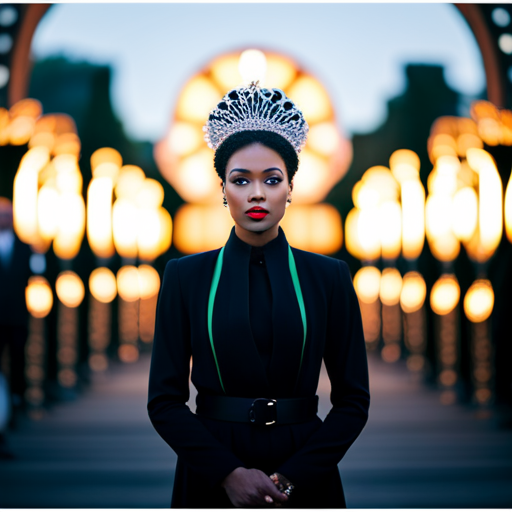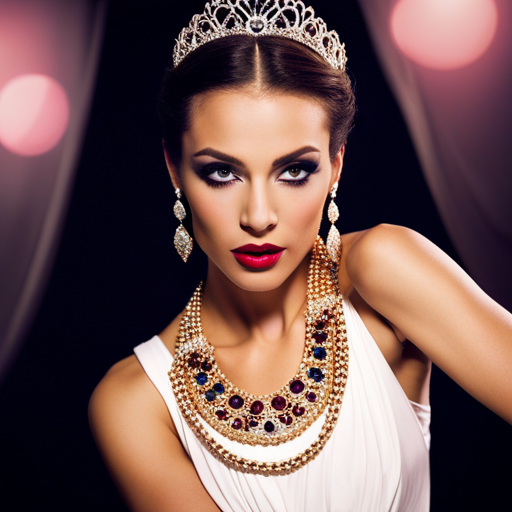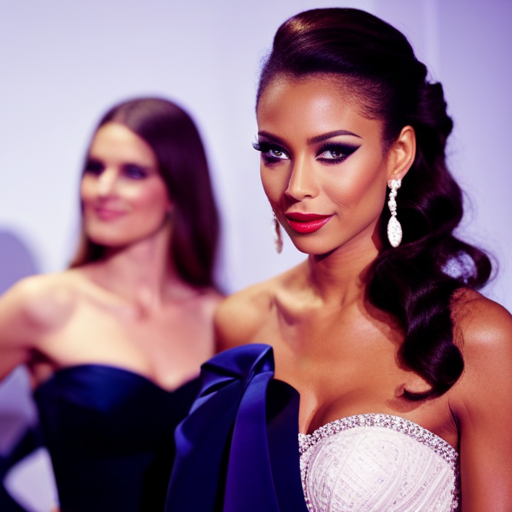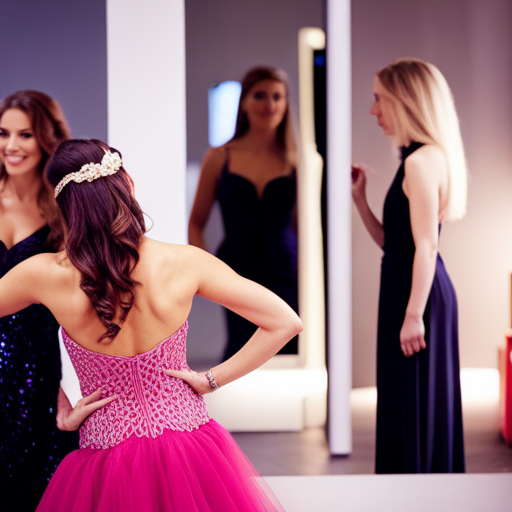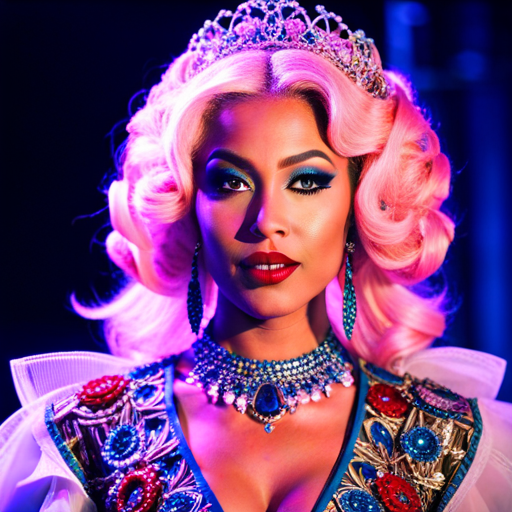The Evolution of Pageant Dresses Through the Decades
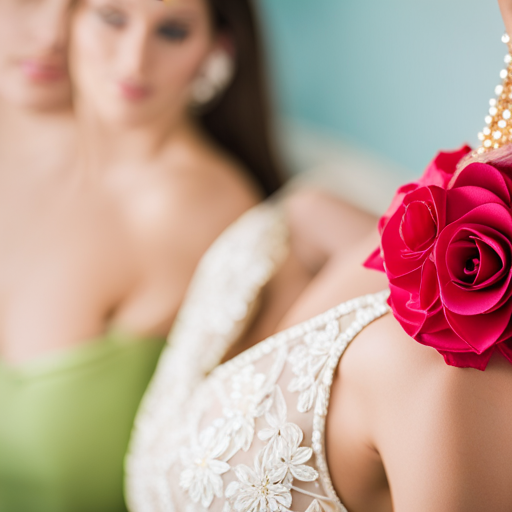
Every rose has its thorn, and every decade has its own unique style of pageant dresses.
From the golden age of glamour in the 1950s to the contemporary couture of the 2010s, the evolution of pageant dresses has reflected the shifting trends and cultural influences of each era.
Join us on a journey through time as we explore the evolution of pageant dresses through the decades, from the iconic to the avant-garde.
1950s: The Golden Age of Glamour
In the 1950s, pageant dresses underwent a transformation, embracing opulent fabrics, intricate embellishments, and figure-flattering silhouettes, marking the era as the Golden Age of Glamour in pageantry. This period saw the evolution of pageant dresses towards timeless elegance, drawing inspiration from vintage designs while embracing the fashion evolution of the time.
The dresses exuded sophistication, with luxurious fabrics like satin and silk, adorned with pearls, rhinestones, and lace, reflecting the opulence of the era. The silhouettes accentuated the female form, with nipped-in waists and full skirts that exuded grace and poise. The modern interpretation of these classic designs still influences pageant dresses today, as they continue to embody the timeless elegance and sophistication of the 1950s.
This era set the stage for the subsequent decades, laying the foundation for the evolution of pageant dresses, culminating in the mod and mini styles of the 1960s.
Transitioning into the subsequent section about the 1960s, the glamour of the 1950s seamlessly gave way to the embracing of mod and mini styles.
1960s: Embracing Mod and Mini
The 60s marked a significant shift in pageant dresses, with mod fashion making a strong influence on the designs.
The era also saw the rise of mini-dresses, reflecting the changing social attitudes and the embrace of a more liberated and youthful aesthetic.
These trends not only transformed the pageant scene but also mirrored the broader cultural shifts of the time.
Mod Fashion Influence
Embracing the mod and mini fashion trends of the 1960s, pageant dresses underwent a significant evolution in style and silhouette. The mod fashion movement, with its vintage inspiration, sparked innovative designs that revolutionized the pageant dress landscape.
This era saw a departure from traditional floor-length gowns, giving way to shorter hemlines and bold, geometric patterns. The influence of mod fashion also brought about a shift towards more form-fitting silhouettes, accentuating the natural curves of the wearer.
Additionally, the use of unconventional materials like PVC and bold color combinations became prevalent, adding a sense of playfulness and individuality to pageant attire.
Rise of Mini-Dresses
With the emergence of mod and mini fashion trends in the 1960s, pageant dresses experienced a significant shift towards shorter hemlines and more form-fitting silhouettes. The mini dress resurgence marked a fashion revolution, as it brought a daring and youthful energy to pageant attire.
Contestants began to embrace the liberating and modern aesthetic of mini-dresses, which allowed for greater freedom of movement on stage and conveyed a sense of confidence and independence. This shift also reflected the changing societal norms and values, as women sought to break free from traditional, conservative styles.
The rise of mini-dresses in pageants during this era not only transformed the way contestants presented themselves but also paved the way for a more diverse and inclusive representation of beauty and style.
1970s: Boho Chic and Disco Fever
In the 1970s, pageant dresses embraced a boho chic and disco fever aesthetic, reflecting the era’s fashion trends and cultural influences. The pageant dresses of this decade were characterized by a fusion of bohemian and disco elements, resulting in a unique and vibrant style that captured the spirit of the times.
-
Boho Chic: Pageant dresses in the 1970s featured flowing silhouettes, floral patterns, and earthy tones, drawing inspiration from the bohemian fashion movement. These dresses exuded a free-spirited and relaxed vibe, incorporating elements such as bell sleeves, peasant tops, and crochet details.
-
Vibrant Prints: The era saw a surge in the popularity of bold and colorful prints, with pageant dresses showcasing psychedelic patterns, paisley designs, and geometric motifs. These eye-catching prints added a dynamic and lively dimension to the dresses, reflecting the exuberance of the disco era.
-
Disco Fever, Sequin Glamour: As the disco craze took hold, pageant dresses also embraced the glitz and glamour of the dance floor. Sequins, metallic fabrics, and shimmering embellishments became prominent features, infusing the dresses with a dazzling allure that epitomized the spirit of disco fever.
1980s: Power Shoulders and Glitz
The 1980s saw a prominent shift in pageant dresses with the emergence of power shoulders and glitzy embellishments, reflecting the bold and assertive fashion trends of the era. Pageant dresses in the 80s were characterized by exaggerated silhouettes, often featuring structured shoulders that projected power and confidence. These dresses were designed to exude a sense of authority and sophistication, aligning with the overall fashion ethos of the decade. Glitz and glam took center stage, with contestants opting for dresses adorned with sequins, metallic fabrics, and intricate beadwork, embodying the opulence and extravagance synonymous with 80s fashion.
The fashion evolution during this period not only transformed pageant dresses but also redefined the standards of elegance and style. The 1980s marked a departure from the romanticism of the 70s, embracing a more ostentatious and bold aesthetic. Pageant contestants embraced the allure of glitz, utilizing it to make a statement and captivate audiences. The power shoulders and glitzy embellishments of this era became emblematic of an unapologetically glamorous and confident approach to pageant attire, leaving an indelible mark on the evolution of pageant dresses.
1990s: Minimalism Meets Elegance
The 1990s witnessed a convergence of minimalism and elegance in pageant dress designs, reflecting a shift towards understated yet refined aesthetics. This era marked a departure from the extravagance of the previous decade and embraced a more subdued, sophisticated approach to pageant attire.
Pageant dresses in the 90s exuded elegance and simplicity, incorporating modern minimalist trends that emphasized clean lines and sleek silhouettes. Sleek silhouettes were favored, with form-fitting designs that accentuated the natural curves of the body. This departure from the voluminous styles of the 80s showcased a newfound appreciation for understated elegance.
The minimalist approach of the 90s emphasized clean lines and simple embellishments, eschewing excessive adornments in favor of a more refined aesthetic. This emphasis on clean, uncluttered designs contributed to the overall sophistication of pageant dresses during this period.
Fabrics such as satin, silk, and crepe became popular choices for pageant dresses in the 90s, adding a touch of luxury and sophistication to the minimalist designs. These refined materials elevated the overall look of the dresses, epitomizing the fusion of minimalism and elegance that defined this era.
2000s: Sparkle and Slit Sensation
Amidst the evolving landscape of pageant dress design, the 0s ushered in a trend characterized by sparkle and a sensation for daring slits.
Pageant dresses in the 0s were all about sparkle and shine, with elegant embellishments adorning the gowns. The dresses were designed to catch the light and dazzle the audience, creating a sense of glamour and sophistication. Sequins, beads, and crystals were commonly used to add shimmer and luster to the gowns, elevating the overall look and making the contestants stand out on stage.
In addition to the focus on sparkle and shine, the 0s also saw a rise in daring slits in pageant dresses. These slits added a touch of allure and sensuality to the gowns, allowing contestants to showcase their confidence and poise as they walked across the stage. The strategic placement of slits in the dresses added an element of drama and sophistication, while also allowing for ease of movement and a modern, fashion-forward aesthetic.
The combination of sparkle and daring slits defined the pageant dress style of the 0s, leaving a lasting impact on the world of beauty pageants.
2010s: Contemporary Couture and Diversity
The 90s marked a significant shift in pageant dress designs, embracing inclusivity and celebrating diversity in beauty standards.
Contemporary couture began to prioritize inclusive designs that catered to a wide range of body types and cultural backgrounds, redefining the traditional pageant aesthetic.
Global influences also played a pivotal role in shaping styles, as designers drew inspiration from diverse cultures to create unique and innovative pageant dresses.
Inclusive Designs Redefine Beauty
During the contemporary couture era of the 2000s, pageant dresses have embraced inclusive designs that redefine traditional beauty standards. Inclusive representation and fashion diversity have become central themes, empowering individuals and promoting body positivity.
Pageant dresses now cater to a wide range of body types, celebrating the beauty of all shapes and sizes. Designers have incorporated diverse cultural influences, reflecting a more globalized and inclusive society.
The focus has shifted towards empowering contestants to feel confident and beautiful in their own skin, regardless of societal norms. This shift has not only transformed the pageant industry but has also set a powerful example for the fashion world as a whole.
Global Influences Shape Styles
Global influences have greatly shaped the styles of pageant dresses in the contemporary couture era, leading to a diverse range of designs that celebrate inclusivity and cultural representation. Cultural fusion has become a prominent theme, with designers drawing inspiration from traditional attire and motifs from various cultures around the world. This fashion evolution has resulted in pageant dresses that beautifully blend elements from different global traditions, creating a rich tapestry of styles. The use of diverse fabrics, embellishments, and silhouettes reflects a celebration of multiculturalism and a shift towards more inclusive and representative designs. The table below showcases some examples of how global influences have shaped contemporary pageant dresses, highlighting the diverse cultural elements that have been incorporated into these stunning creations.
| Cultural Element | Influence on Pageant Dresses |
|---|---|
| Japanese Kimono | Silk fabrics and obi belts |
| Indian Sari | Rich embroidery and draping |
| African Kente Cloth | Bold patterns and vibrant colors |
| Chinese Cheongsam | Mandarin collars and silk fabrics |
| Middle Eastern Abaya | Flowing silhouettes and intricate embellishments |
Frequently Asked Questions
How Did Pageant Dresses Reflect the Social and Political Climate of Each Decade?
Pageant dresses have mirrored societal shifts by adapting to changing fashion trends and reflecting the influence of media and cultural shifts. They have also been a platform for social movements, showcasing the evolving values of each decade.
What Were Some of the Most Iconic Pageant Dress Designers of Each Decade?
Throughout the decades, iconic pageant dress designers have significantly shaped the industry. Their designs have reflected cultural influences, evolving styles, and global perspectives. Recognizing these influential designers is crucial to understanding the evolution of pageant fashion.
How Did Pageant Dress Styles Differ Between Different Regions or Countries?
Pageant dress styles vary significantly across regions and countries, influenced by regional fashion trends, cultural significance, historical context, and societal norms. These factors contribute to the diverse and unique designs seen in pageants worldwide.
What Impact Did Advancements in Technology and Fabric Production Have on Pageant Dress Design Throughout the Decades?
Advancements in technology and fabric production profoundly influenced pageant dress design throughout the decades. Fashion trends, societal expectations, and body positivity movements also played pivotal roles, reflecting the evolving beauty standards and regional differences. Iconic designers further shaped this dynamic landscape.
How Have Beauty Standards and Body Positivity Movements Influenced Pageant Dress Styles Over Time?
Beauty standards and body positivity movements have significantly influenced pageant dress styles. Inclusivity is reflected in diverse fashion trends, fabric technology, and cultural influences, resulting in regional variations that celebrate individuality and empowerment.
Conclusion
In conclusion, the evolution of pageant dresses through the decades has been a reflection of the changing cultural and fashion trends.
From the glamorous and sophisticated styles of the 1950s to the contemporary couture and diversity of the 2010s, pageant dresses have evolved to embrace new ideas and embrace diversity.
It will be intriguing to see how future decades will continue to shape and redefine the concept of pageant dresses.

